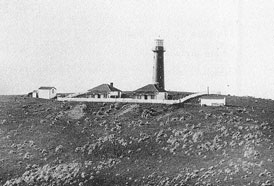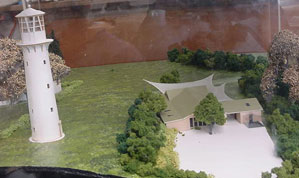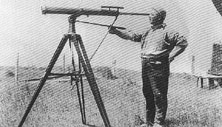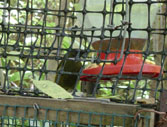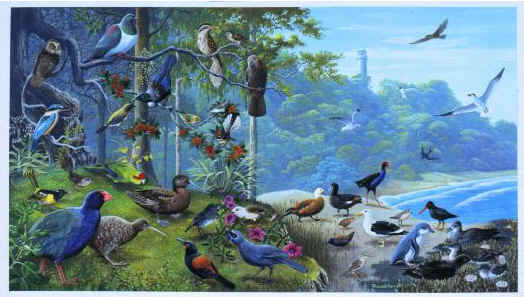 |
 |
Our |
||
Red Beach School
Tiritiri Matangi Island
Our Project
|
History | Lighthouse | Tiritiri Matangi Sanctuary | Landscape of Tiritiri Matangi | Birds | Examples of non-endangered birds | Tiritiri Matangi volunteers Māori were the first settlers on Tiritiri Matangi. They brought kiore (Polynesian rats) and dogs. They cleared the forest and hunted birds like petrel and shearwater chicks. The Māori moved back to the mainland to escape warriors approaching from the north. When the Europeans came they moved onto Tiritiri Matangi. They burned the remaining forest for farmland. All that was left were the pohutukawa trees on the cliffs and the banks. Farmers sowed pasture grasses of cocksfoot and clover to feed their animals. The lighthouse, which was originally painted red, and the first two lighthouse-keepers' cottages. About 100 years ago (1864) there were many ships coming into the Auckland harbour, they were in great danger because of the rocky shore. The government decided that Tiritiri Matangi was the best place to build a lighthouse. The lighthouse is 20.5 metres high and built from pre-fabricated iron plates brought to New Zealand from England. Twelve bullocks dragged the plates from the beach to the highest point of Tiritiri Matangi. The lighthouse was opened on 1 January 1865. A wick lamp fuelled by whale oil first powered the lighthouse. In 1925, the lighthouse was fitted with an acetylene-burning fixed light. In 1955, the lighthouse was fitted with a bulb powered by a diesel generator. In 1956, Sir Ernest Davis donated an 11 million candlepower xenon lamp. The eight beams flashed every 15 seconds, which made the lighthouse the most powerful in the southern hemisphere. In 1967, an underwater cable was laid, linking Tiritiri Matangi to the national power grid. In April 1984, the Tiritiri Matangi light was replaced by a smaller, less powerful quartz iodine lamp. In 1986, the power cable was broken and now the lighthouse uses solar power producing a 300,000 candlepower beam. This is a model of the lighthouse. Tiritiri Matangi, an open sanctuary Tiritiri Matangi Island is an open bird sanctuary for rare and endangered native New Zealand birds. Everyone can visit Tiritiri Matangi it's a great place to learn about some of our wonderful New Zealand birds. Over 20,000 visitors come to Tiritiri Matangi each year, so it's a great place to visit.Landscape and Bush of Tiritiri Matangi Tiritiri Matangi Island has a number of vast forests, plants and many marine landscapes. Many volunteers have offered to help restore Tiritiri Matangi Island to it's natural form. Over 250,000 trees, plants, flowers and shrubs have been planted over the past few decades. Titoki (Alectryon excelsus), Toropapa pere (Alseuosmia banksii), Rangiora (Brachyglottis repanda), Tawa (Beilsch) and Karamu are all trees on Tiritiri Matangi Island. There at least 400 more species! Here's a list of trees and plants on Tiritiri island! Enjoy! North Island broom, kaka beak, taupata, mingimingi, te kouka, korokio taranga, turutu, akeake, kohkohe, hinau, whau, kotukutuku, creeping fuchsia, hangehange, koromiko, porokaiwhiri, New Zealand honeysuckle and many more! Many wattle trees in Wattle Valley provide shade and an amazing food source in the scarce winters. Pohutakawas are a very popular tree and do not require much care. A rather exotic tree, the pohutakawa, has lush red flowers very similar to that of the bottlebrush. It provides many essential needs for the island itself and also the wildlife. The seeds that fall from the delicate flowers make excellent forestry – one seed can produce many trees. Pohutakawas have outlined the parameter of the island, making it a very beautiful home for the birds. Waterways are also a very popular home for the wildlife. The signal station being operated to identify ships entering the habour. The endangered birds on Tiritiri Matangi Island: The little spotted kiwi is also known as kiwi pukupuku, "the flightless bird". It is white, brown, black and has sharp claws! The brown teal is also know as pateke. It is a type of duck. They are usually found in rivers or in waterways. The takahe is a lovely shade of blue with some green over the top. There are only 200 in the world and 60 of them are on Tiritiri Matangi Island! The red crowned parakeet is also known as the kakariki. They have tropical green bodies, and they are blue under their wings. A special feature about them is the red crown on their heads. The whitehead is also known as popokatea. It has a white body and brown tail. The North Island robin is also known as toutouwai. They have a dark grey body, white under-belly, and a black tail! The stitchbird is also known as the hihi. They have a dark grey and black head and wings, a white under-belly, and a shade of yellow on their tails and on their body! The North Island kokako has a grey body, a black beak and a bright blue bib! The North Island saddleback is also known as tieke. They are black with a reddish-brown saddle on their backs. The fernbird is also known as matata. A bellbird feeding. Examples of the non-endangered birds on Tiritiri Matangi Island:
This is a wonderful painting of all the birds on Tiritiri Matangi. It was painted by Ron Commetti. The supporters of Tiritiri Matangi get no money for what they do. They help with planting, building, and feeding, and mostly help save the birds on Tiritiri Matangi Island. Their three objectives are:
Before Tiritiri Matangi was an open sanctuary, it was farmland. All the island was just grass, but now it's full of life with trees, plants, flowers and tonnes of birds – thanks to the help of all the volunteers. Replanting all of Tiritiri Matangi Island started out to be just a small experiment, but it turned into a huge project. It has shown how important volunteers are to a conservation project. © Copyright 2002 Opal, Courtney, Georgia, Holly, Ashleigh, James, Ben, Carl, Brooke, Nicole |
